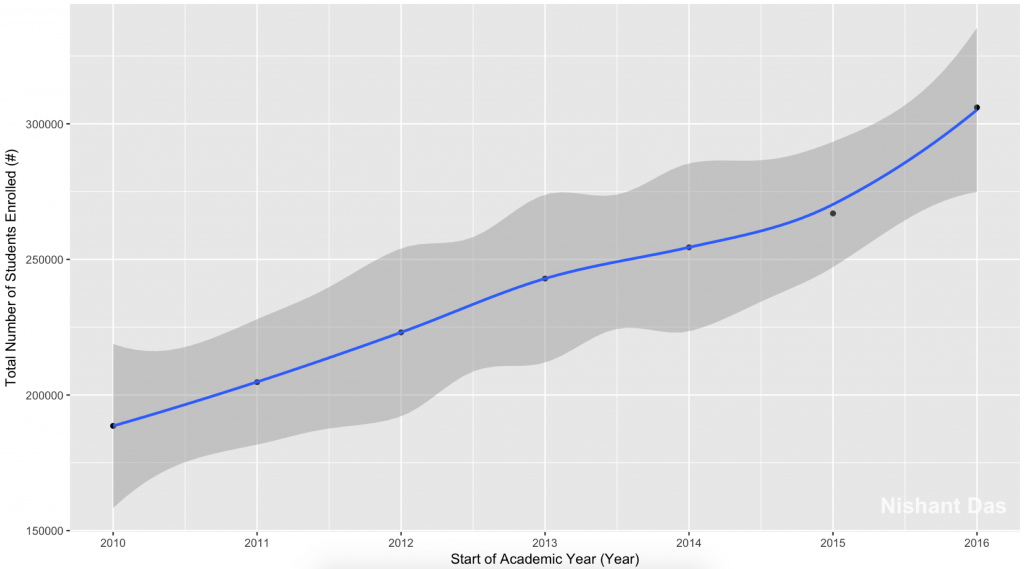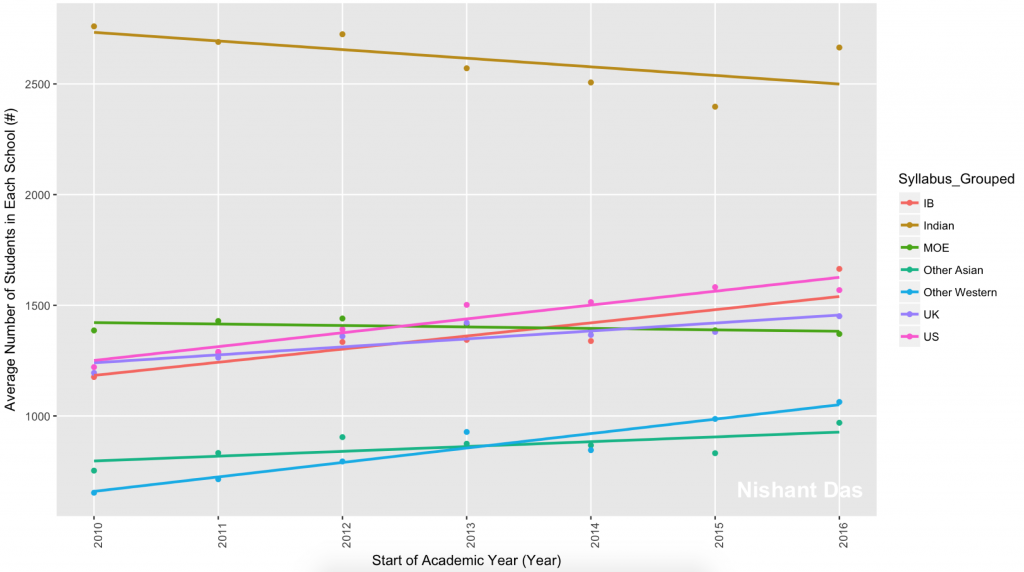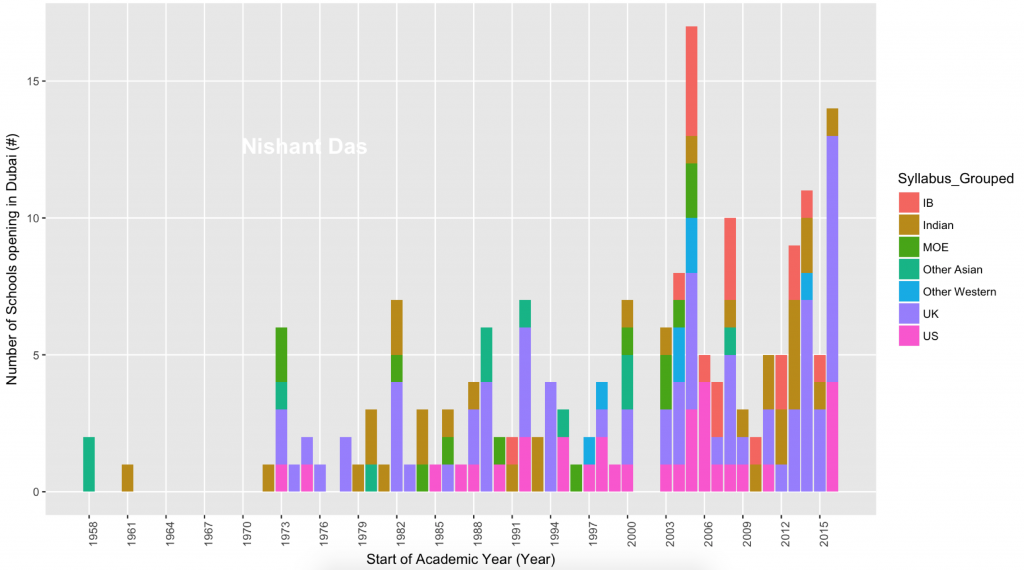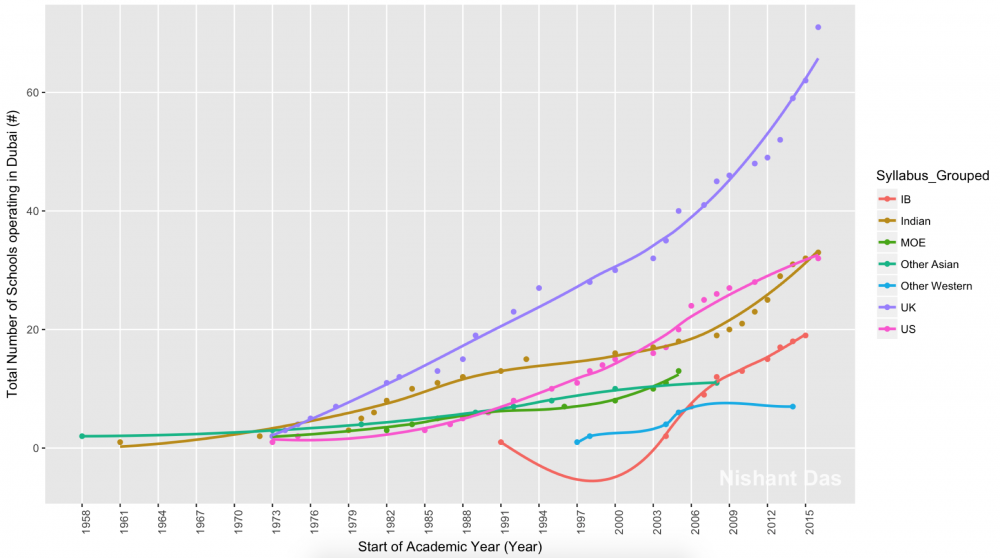Ever Increasing Market Demand for Schools
The total number of students enrolled in Dubai schools as of 2016-2017 is 306,016. As seen from figure 1 below, the trend since 2010 has been that the number of students enrolled in Dubai is increasing every year.
The average year-on-year increase is about 16,773 more students enrolled than the year before. Year 2016-2017 had close to 40,000 more students enroll than the year before. This is the steepest increase in the number of student enrolled. Increase in enrollment for all other years has been less than 20,000 students.
By using linear regression modeling on data from 2010 to the present, we can estimate that the number of students enrolled in 2017-2018 will be about 313536 and Dubai will have about half a million students registered in its school by 2027.
Exponential Rise in Number of Schools
How is the education industry responding to the increasing number of students? We examine the new schools being opened in Dubai since the 1960’s.
As we can see from figure 2 below, there is an exponential rise in the number of schools operating in Dubai. With the first school opening in 1958, Dubai has about 186 operating as of 2016-2017.
Year-on-Year New Schools in Dubai
Figure 3 shows the number of new schools opening in Dubai for every year since 1958. As we can see in the graph below, where we apply a best fit line to the same data, the number of schools opening every year was relatively stable and growing very slowly between 1960 to 1992. In fact, between this time period, on average, only 2.5 new schools were opening every year. However, from 1992 onwards there was a steep rise in the number of new schools opening in Dubai.
The average number of new schools opening in Dubai between
- 1993 to 2000 was 3 new schools every year.
- 2001 to 2010 was 6.88 new schools every year.
- 2011 to the present is about 8.2 new schools every year.
2005 saw 17 new schools opening in Dubai, the highest number of new schools that opened in Dubai followed by 2016 which saw 14 new schools opening in Dubai.
Location of New Schools
Figure 4 below shows us where new schools are opening in each half-decade from 1955 onwards. We can see some interesting trends over this time period,
- Between 1955 to 1980, school were generally opening in Karama, Oud Metha, Umm Hurair, Safa, Mizhar, etc.
- Between 1980 to 2000, schools were generally opening in Barsha, Garhoud, Muhaisnah, Al Qusais, etc.
- From 2000 onwards, schools are opening in Barsha, Warqa, Nad Al Sheba as well as in new developments in areas such as Mirdif, Meydan, Emirates Hilles, Arabian Ranches, Dubai Sports City, Al Khail, DIP, etc.
- In the last decade, Barsha and Al Khail are the places where most schools are opening.
Average number of students in each school
It is clear that Dubai’s education industry is adapting to the ever-increasing number of students in Dubai by opening more and more new schools. Let’s explore the average number of students per school to get a better sense of how exactly the schools are meeting the increasing demand for schools.
The graph below shows the average enrollment for all schools across Dubai from the academic year 2010-2011 to 2016-2017. The trend line shows that the average number of students in a school is gradually increasing since 2010. We can see that currently the average number of students in each school is around 1655 students per school.
Average number of students in each school by Location
As we can see in Figure 6 below, location plays an important role in the average number of students in a school. Locations such as Garhoud, Jebel Ali, Al Warqa’a and Dubai Silicon Oasis have schools where the average enrolment is relatively higher (around 3000 students per school) than other locations.
Some locations are relatively stable in the average number of students over the years. Some of these include Meadows, Mamzar, Umm Hurair, etc. While some locations are seeing an increase in the average enrollment. These include Dubai Silicon Oasis, Dubai Investment Park, Jumeriah, Umm Al Sheif, etc.
Average number of students in each Dubai school by Syllabus
The graph below, where the average number of students in each school is displayed by the different syllabus helps us understand the data better.
We can categories the Dubai schools into 3 different groups.
Indian Schools, which have on average around 2600 students per school. Fitting a regression line on the data, we can see a downward trend over time, i.e. the average number of students in Indian schools is decreasing over time.
IB, MOE, UK & US Schools, which have on average around 1500 students per school. The average number of students per school breakdown is as follows,
- IB – 1664 students per school.
- UK – 1450 students per school.
- US- 1568 students per school.
- MOE – 1370 students per school.
Other Asian & Other Western Schools, which have on average close to 1000 students in each school. These schools include Syllabus catering to specific communities and it is understandable that the average number of students in these schools will be smaller.
Grouping of Other Asian & Other Western Schools
Other Asian Syllabus schools include schools that have the following syllabus:
- Iranian
- Japanese
- Pakistan
- Philippines
Other Western Syllabus schools include schools that have the following syllabus:
- Canadian
- French
- German
- Russian
We have grouped these schools together as Other Asian & Other Western because the number of schools for each of the above-mentioned syllabus are too few in number to be statistically significant and for more effective graphical plotting.
New Schools opening in Dubai grouped by their Syllabus
The graph below is the same as Figure 3 above but in a histogram format detailing the Syllabus of new schools opening in Dubai since 1958.
The most popular School Syllabus
The following graph shows the total number of schools in Dubai every year by Syllabus.
As we can see, there is an explosion in the number of UK schools opening and operating in Dubai. About 71 UK syllabus schools are operating in Dubai, making it the most popular curriculum in Dubai.
The next steepest increase is in Indian, US and IB schools, with 33, 32 and 19 schools operating in Dubai currently respectively.
The number of MOE, Other Asian & Other Western schools are also increasing, but at a much smaller rate.
The first Indian School opened in 1961. While the year 1973 saw the first school of many curriculums including US and British. The first IB school opened in Dubai in 1991 and was the only IB school till 2004, after which, there was a sudden increase in the number of IB Schools opening in Dubai
Where do the various Syllabus tend to be located?
The following graph shows the number of schools in different locations across the different Syllabus for the year 2016 to 2017.
We can see that Barsha has 6 of UK & US schools and 2 IB schools operating along with 1 Indian & MOE school.
Muhasinah has almost all curriculums except for IB.
Looking at the graph it can be noted that where you find UK schools, you tent to find US schools (or vica versa). This helps us visualize how location plays an important part in the school syllabus being offered by schools in a given location.
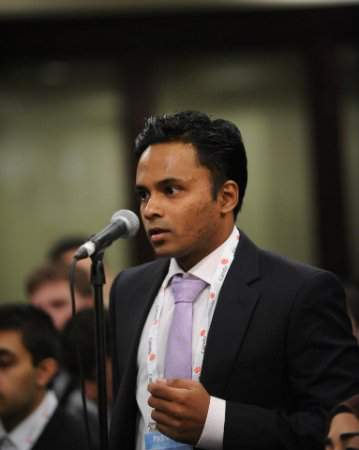
Nishant Das is a Data Scientist & Consultant at Marketways Arabia. He has over 7 years of experience as a management consultant, working with clients gain the edge through customized data analysis.
He is passionate about Big Data Analytics with a focus on Machine Learning, Predictive Modeling & Data Visualization using languages such R, Python, Scala, etc. He believes the key to leverage the power that lies within data is asking the right questions.
Nishant holds a Bachelors degree in Engineering from McMaster University, Canada with a specialization in Engineering Physics (Nuclear Engineering & Renewable Energy).
He can be contacted on thenishantdas@gmail.com

